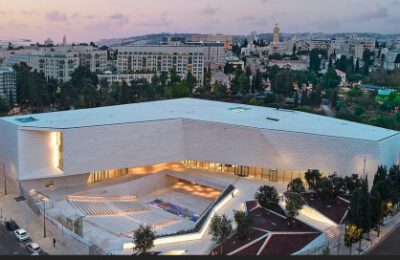HAS a piece of music ever brought you to laughter?
Not me. This doesnt happen, at least in my experience.
Yet, music can bring a person to tears.
So can a moving sermon, story, or piece of writing.
Congregation Ahavas Torah in Monsey, New York, is place where one is moved to laughter, or to tears.
Or to deep thought.
Absent an overwhelming, Carlebach-type davening with its scripted tunes, the mark of Ahavas Torah in Monsey is spontaneity, a joyous outreaching to G-d.
Sometimes one is transported with an entire tune, other times with the merest musical phrase. Always, standing in front is Rabbi Ephraim Wachsman.
Sometimes he is the conductor, sometimes the conducted. But always, the rabbi, and indispensable.
His music is, yes, music. Some of the tunes in his shul I have heard nowhere else. He is a profound composer of melodies to familiar prayers, such as the introduction to the Grace after Meals (shir ha-maalos, the 126th psalm).
Even more, his music is the seamless tapestry of Jewish thought that he spins right in front of your eyes, in the merest of minutes.
Some rabbinic preachers cite authorities left and right to show that they can. Some cite sources in a stilted sense, either missing the feel of the source or mismatching it with another. I have heard more than my share of preachers whose textual sources dont really fit together, or dont really say what the preacher says they say.
With Rabbi Wachsman, the sources blend and assume new shades and textures with the greatest of ease and profundity, like a diamond rotating in the sun, sending out new shafts of light, each integral to the origin point.
With Rabbi Wachsman, an idea from the Elder of Slobodka, a comment of the Rizhiner Rebbe, a midrash, a Rashi, a technical point in Jewish law the one flows into and illuminates the next, and is illuminated by the next, all coming together to convey a cogent and significant idea.
I HAD the privilege of listening to Rabbi Wachsman four times last Shabbos. He first entered my consciousness a few years ago in the Continental Airlines Arena in New Jersey. The occasion was the massively attended conclusion of the seven-and-a-half-year cycle of the daily page of Talmud study, the siyyum ha-Shas. Rabbi Wachsman electrified the audience with his talk.
I made a mental note.
Little did I know that Dr. Seymour and Lynn Kushnir, the parents of the young man who would become one of our sons-in-law, were members of his synagogue in Monsey, New York.
And so, when I found myself in his shul I learned as he is in his thought, so he is in his person.
He dresses like a chasid, yet was trained in the bastion of the opposite side of the spectrum, the Lakewood yeshiva. He is equally at home with the chasidic masters (this week it was the Rizhiner Rebbe), the musar masters (this week it was the Elder of Slobodka, mentor of Lakewoods founder) and the wide range of halachic masters.
Perhaps of equal note is his congregation. The members are by turns good listeners, questioners, and inquirers, not to mention capable of being moved and of moving others, via their davening.
I was a visitor. I really dont know the scene and cannot evaluate various other information that flowed into my ears, such as: Rabbi Wachsman knows a lot of science; Rabbi Wachsman plays musical instruments and has written skits for summer camps; Rabbi Wachsman has memorized large tracts of Talmudic literature; Rabbi Wachsman has founded a yeshiva that, in short order, is on a great growth spurt.
I know only one thing. Although I do not have the opportunity to get to Monsey, New York very often, I can I look forward to a spiritual treat: Shabbos at Congregation Ahavas Torah.












